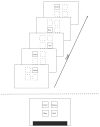Implicit statistical learning in language processing: word predictability is the key
- PMID: 19922909
- PMCID: PMC2823831
- DOI: 10.1016/j.cognition.2009.10.009
Implicit statistical learning in language processing: word predictability is the key
Abstract
Fundamental learning abilities related to the implicit encoding of sequential structure have been postulated to underlie language acquisition and processing. However, there is very little direct evidence to date supporting such a link between implicit statistical learning and language. In three experiments using novel methods of assessing implicit learning and language abilities, we show that sensitivity to sequential structure - as measured by improvements to immediate memory span for structurally-consistent input sequences - is significantly correlated with the ability to use knowledge of word predictability to aid speech perception under degraded listening conditions. Importantly, the association remained even after controlling for participant performance on other cognitive tasks, including short-term and working memory, intelligence, attention and inhibition, and vocabulary knowledge. Thus, the evidence suggests that implicit learning abilities are essential for acquiring long-term knowledge of the sequential structure of language - i.e., knowledge of word predictability - and that individual differences on such abilities impact speech perception in everyday situations. These findings provide a new theoretical rationale linking basic learning phenomena to specific aspects of spoken language processing in adults, and may furthermore indicate new fruitful directions for investigating both typical and atypical language development.
Copyright 2009 Elsevier B.V. All rights reserved.
Figures





Similar articles
-
Contribution of implicit sequence learning to spoken language processing: some preliminary findings with hearing adults.J Deaf Stud Deaf Educ. 2007 Summer;12(3):317-34. doi: 10.1093/deafed/enm019. Epub 2007 Jun 4. J Deaf Stud Deaf Educ. 2007. PMID: 17548805 Free PMC article.
-
Effects of Vocabulary and Implicit Linguistic Knowledge on Speech Recognition in Adverse Listening Conditions.Am J Audiol. 2019 Oct 16;28(3S):742-755. doi: 10.1044/2019_AJA-HEAL18-18-0169. Epub 2019 Oct 16. Am J Audiol. 2019. PMID: 32271121
-
Some Neurocognitive Correlates of Noise-Vocoded Speech Perception in Children With Normal Hearing: A Replication and Extension of ).Ear Hear. 2017 May/Jun;38(3):344-356. doi: 10.1097/AUD.0000000000000393. Ear Hear. 2017. PMID: 28045787 Free PMC article.
-
The Role of Statistical Learning in Understanding and Treating Spoken Language Outcomes in Deaf Children With Cochlear Implants.Lang Speech Hear Serv Sch. 2018 Aug 14;49(3S):723-739. doi: 10.1044/2018_LSHSS-STLT1-17-0138. Lang Speech Hear Serv Sch. 2018. PMID: 30120449 Free PMC article. Review.
-
Lexical learning and lexical processing in children with developmental language impairments.Philos Trans R Soc Lond B Biol Sci. 2013 Dec 9;369(1634):20120387. doi: 10.1098/rstb.2012.0387. Print 2014. Philos Trans R Soc Lond B Biol Sci. 2013. PMID: 24324231 Free PMC article. Review.
Cited by
-
Recognition of vocoded words and sentences in quiet and multi-talker babble with children and adults.PLoS One. 2020 Dec 29;15(12):e0244632. doi: 10.1371/journal.pone.0244632. eCollection 2020. PLoS One. 2020. PMID: 33373427 Free PMC article.
-
Statistically based chunking of nonadjacent dependencies.J Exp Psychol Gen. 2022 Nov;151(11):2623-2640. doi: 10.1037/xge0001207. Epub 2022 Apr 25. J Exp Psychol Gen. 2022. PMID: 35467930 Free PMC article.
-
Reading fluency and statistical learning across modalities and domains: Online and offline measures.PLoS One. 2023 Mar 23;18(3):e0281788. doi: 10.1371/journal.pone.0281788. eCollection 2023. PLoS One. 2023. PMID: 36952465 Free PMC article.
-
A role for incidental auditory learning in auditory-visual word learning among kindergarten children.J Vis. 2020 Mar 17;20(3):4. doi: 10.1167/jovi.20.3.4. J Vis. 2020. PMID: 32181860 Free PMC article.
-
On-line individual differences in statistical learning predict language processing.Front Psychol. 2010 Sep 14;1:31. doi: 10.3389/fpsyg.2010.00031. eCollection 2010. Front Psychol. 2010. PMID: 21833201 Free PMC article.
References
-
- Baddeley AD. Working memory. Oxford, UK: Oxford University Press; 1986.
-
- Bar M. The proactive brain: Using analogies and associations to generate predictions. Trends in Cognitive Sciences. 2007;11:280–289. - PubMed
-
- Bernhardt BM, Kemp N, Werker JF. Early word-object associations and later language development. First Language. 2007;27:315–328.
-
- Bilger RC, Rabinowitz WM. Relationships between high- and low-probability SPIN scores. The Journal of the Acoustical Society of America. 1979;65(S1):S99.
Publication types
MeSH terms
Grants and funding
LinkOut - more resources
Full Text Sources
Other Literature Sources

